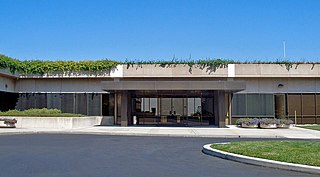
Nokia Bell Labs is an American industrial research and scientific development company owned by Finnish company Nokia. With headquarters located in Murray Hill, New Jersey, the company operates several laboratories in the United States and around the world. Bell Labs has its origins in the complex past of the Bell System.

PARC is a research and development company in Palo Alto, California. Founded in 1969 by Jacob E. "Jack" Goldman, Xerox Corporation's chief scientist, the company was originally a division of Xerox, tasked with creating computer technology-related products and hardware systems.

Los Alamos National Laboratory is a United States Department of Energy national laboratory initially organized during World War II for the design of nuclear weapons as part of the Manhattan Project. It is a short distance northwest of Santa Fe, New Mexico, in the southwestern United States.

The Salk Institute for Biological Studies is a scientific research institute located in the La Jolla community of San Diego, California on the Pacific coast. The independent, non-profit institute was founded in 1960 by Jonas Salk, the developer of the polio vaccine; among the founding consultants were Jacob Bronowski and Francis Crick. Construction of the research facilities began in spring of 1962. The Salk Institute consistently ranks among the top institutions in the US in terms of research output and quality in the life sciences. In 2004, the Times Higher Education Supplement ranked Salk as the world's top biomedicine research institute, and in 2009 it was ranked number one globally by ScienceWatch in the neuroscience and behavior areas.

William Daniel "Danny" Hillis is an American inventor, entrepreneur, and scientist, who pioneered parallel computers and their use in artificial intelligence. He founded Thinking Machines Corporation, a parallel supercomputer manufacturer, and subsequently was a fellow at Walt Disney Imagineering. More recently, Hillis co-founded Applied Minds and Applied Invention, an interdisciplinary group of engineers, scientists, and artists. He is a visiting professor at the MIT Media Lab.

The Goddard Space Flight Center (GSFC) is a major NASA space research laboratory located approximately 6.5 miles (10.5 km) northeast of Washington, D.C. in Greenbelt, Maryland, United States. Established on May 1, 1959 as NASA's first space flight center, GSFC employs approximately 10,000 civil servants and contractors. It is one of ten major NASA field centers, named in recognition of American rocket propulsion pioneer Robert H. Goddard. GSFC is partially within the former Goddard census-designated place; it has a Greenbelt mailing address.
The Howard Hughes Medical Institute (HHMI) is an American non-profit medical research organization based in Chevy Chase, Maryland. It was founded in 1953, by Howard Hughes who was an American business magnate, investor, record-setting pilot, engineer, film director, and philanthropist, who was known during his lifetime as one of the most financially successful individuals in the world. It is one of the largest private funding organizations for biological and medical research in the United States. HHMI spends about $1 million per HHMI Investigator per year, which amounts to annual investment in biomedical research of about $825 million.

The University of Massachusetts Medical School is a public medical school in Worcester, Massachusetts. It is part of the University of Massachusetts (UMass) system. It is home to three schools: the School of Medicine, the Graduate School of Biomedical Sciences, and the Graduate School of Nursing, as well as a biomedical research enterprise and a range of public-service initiatives throughout the state.

Cochin University of Science and Technology (CUSAT) is a state government-owned autonomous university in Kochi, Kerala, India. It was founded in 1971 and has two campuses: one in Kochi, and one in Kuttanad, Alappuzha, 66 km (41 mi) inland. The university awards degrees in engineering and science at the undergraduate, postgraduate and doctoral levels.

Confocal microscopy, most frequently confocal laser scanning microscopy (CLSM) or laser confocal scanning microscopy (LCSM), is an optical imaging technique for increasing optical resolution and contrast of a micrograph by means of using a spatial pinhole to block out-of-focus light in image formation. Capturing multiple two-dimensional images at different depths in a sample enables the reconstruction of three-dimensional structures within an object. This technique is used extensively in the scientific and industrial communities and typical applications are in life sciences, semiconductor inspection and materials science.

Novosibirsk State University (NSU) is one of Russia's leading institutions of higher-education. It is located in Novosibirsk, a cultural and industrial center in Siberia. NSU has an important profile as the producer of much of Russia's academic elite. The University was founded in 1958 on the principles of the integration of education and science, the early involvement of students with research activities at all levels, and the engagement of leading scientists in its teaching programmes.

The Pakistan Institute of Nuclear Science & Technology (PINSTECH) is a federally funded multiprogram science and technology national research institute and national laboratory site managed for the Government of Pakistan's federal ministries by the Institute of Engineering and Applied Sciences (PIEAS).
The Coordinated Science Laboratory (CSL) is a major scientific research laboratory at the University of Illinois at Urbana–Champaign. With deep roots in information technology, CSL has invented and deployed many landmark innovations, such as the electric vacuum gyroscope, the first computer-assisted instructional program and the plasma TV. Today, research thrusts include computer vision, economics and energy systems, information trust, neuroengineering, parallel computing, robotics and more.

The Environmental Research Institute of Michigan (ERIM) was a research institute at Ann Arbor, Michigan, founded in 1972. The institute contributed to the development of remote sensing, radar, and holography. ERIM grew out of a military and environmental research arm of the University of Michigan, the Michigan Aeronautical Research Center, later known as the Willow Run Research Center.

Dmitri Z. Garbuzov was one of the pioneers and inventors of room temperature continuous-wave-operating diode lasers and high-power diode lasers.
This article outlines the history of natural scientific research in Canada, including physics, astronomy, space science, geology, oceanography, chemistry, biology, and medical research. Neither the social sciences nor the formal sciences are treated here.
This article outlines the history of Canadian technological invention. Technologies chosen for treatment here include, in rough order, transportation, communication, energy, materials, industry, public works, public services, domestic/consumer and defence technologies.

The Institute of Physics (IOP) of the National Academy of Sciences of Ukraine founded in 1926 is the oldest research institution of physical science within the Academy. Being on the path of both infrastructure development and research diversification for more than 80 years, the Institute has eventually originated five more specialized research institutions.
William Taylor Ham was an American health physicist and founding member of the Health Physics Society.
Dilip Devidas Bhawalkar is an Indian optical physicist and the founder director of the Raja Ramanna Centre for Advanced Technology (CAT), an institute under the Department of Atomic Energy, serving as a centre for higher studies in the fields of lasers and particle accelerators. He is credited with pioneering research in optics and lasers in India and is reported to have contributed in making CAT a partner in the International Linear Collider and Large Hadron Collider experiments of the European Organization for Nuclear Research (CERN). He is a recipient of the Shanti Swarup Bhatnagar Prize, the highest Indian award in science and technology. The Government of India awarded him the fourth highest civilian award of the Padma Shri in 2000.













